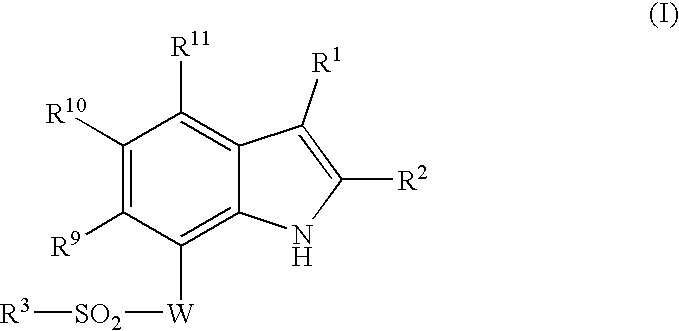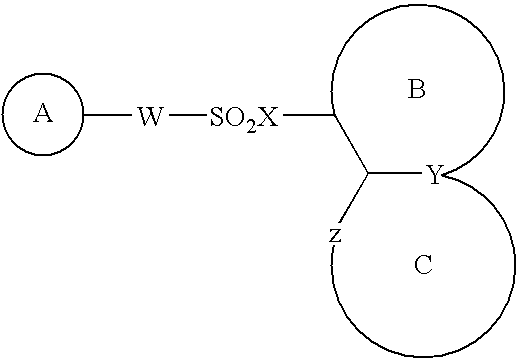Indole compound
a technology of indole and compound, which is applied in the field of indole compound, can solve the problems of impaired glucose tolerance and diabetes, insulin secretion failure, and lower liver glucose metabolism, and achieve the effects of superior stability, superior glucokinase activation action, and superior properties of pharmaceutical products
- Summary
- Abstract
- Description
- Claims
- Application Information
AI Technical Summary
Benefits of technology
Problems solved by technology
Method used
Image
Examples
reference example 1
ethyl 1-(methoxymethyl)-7-nitro-1H-indole-2-carboxylate
[1400]
[1401]To a suspension of sodium hydride (60%, in oil, 0.51 g) in N,N-dimethylformamide (15 ml) was slowly added ethyl 7-nitro-1H-indole-2-carboxylate (2.50 g) at 0° C., and the mixture was stirred for 30 min. Chloromethyl methyl ether (1.00 ml) was added to the reaction mixture over 20 min at 0° C., and the mixture was stirred at room temperature for 1 hr. Water was added to the reaction mixture, and the mixture was extracted with ethyl acetate. The ethyl acetate layer was washed with saturated brine, dried (MgSO4), and concentrated. The obtained residue was subjected to silica gel column chromatography to give the title compound (2.29 g, yield 77%) as pale-yellow crystals from a fraction eluted with ethyl acetate-hexane (1:3, volume ratio). melting point 62-63° C.
reference example 2
ethyl 7-amino-1-(methoxymethyl)-1H-indole-2-carboxylate
[1402]
[1403]A mixture of ethyl 1-(methoxymethyl)-7-nitro-1H-indole-2-carboxylate (2.35 g), 10% palladium-carbon (0.24 g), ethanol (4 ml) and tetrahydrofuran (10 ml) was stirred overnight at room temperature under hydrogen atmosphere. The palladium-carbon was removed by filtration, and the filtrate was concentrated. The residue was subjected to silica gel column chromatography to give the title compound (1.92 g, yield 91%) as a yellow oil from a fraction eluted with ethyl acetate-hexane (1:3, volume ratio).
[1404]1H-NMR (CDCl3)δ: 1.41 (3H, t, J=7.2 Hz), 3.44 (3H, s), 4.36 (2H, q, J=7.2 Hz), 4.53 (2H, brs), 6.16 (2H, s), 6.61 (1H, dd, J=7.7, 0.9 Hz), 6.97 (1H, t, J=7.7 Hz), 7.10 (1H, dd, J=7.7, 0.9 Hz), 7.28 (1H, s).
reference example 3
ethyl 1-(methoxymethyl)-7-[(2-thienylsulfonyl)amino]-1H-indole-2-carboxylate
[1405]
[1406]To a mixture of ethyl 7-amino-1-(methoxymethyl)-1H-indole-2-carboxylate (0.70 g) and pyridine (8 ml) was added thiophene-2-sulfonyl chloride (0.57 g) at 0° C., and the mixture was stirred at room temperature for 2 hr. The reaction mixture was concentrated, 10% aqueous citric acid solution was added, and the mixture was extracted with ethyl acetate. The ethyl acetate layer was washed with saturated brine, dried (MgSO4), and concentrated. The obtained residue was subjected to silica gel column chromatography to give the title compound (1.03 g, yield 93%) as a yellow oil from a fraction eluted with ethyl acetate-hexane (1:2, volume ratio).
[1407]1H-NMR (CDCl3)δ: 1.40 (3H, t, J=7.2 Hz), 3.45 (3H, s), 4.35 (2H, q, J=7.2 Hz), 5.70 (2H, s), 7.00 (1H, dd, J=5.1, 3.7 Hz), 7.19 (1H, t, J=7.8 Hz), 7.32 (1H, s), 7.46-7.64 (4H, m), 8.87 (1H, brs).
PUM
 Login to View More
Login to View More Abstract
Description
Claims
Application Information
 Login to View More
Login to View More - R&D
- Intellectual Property
- Life Sciences
- Materials
- Tech Scout
- Unparalleled Data Quality
- Higher Quality Content
- 60% Fewer Hallucinations
Browse by: Latest US Patents, China's latest patents, Technical Efficacy Thesaurus, Application Domain, Technology Topic, Popular Technical Reports.
© 2025 PatSnap. All rights reserved.Legal|Privacy policy|Modern Slavery Act Transparency Statement|Sitemap|About US| Contact US: help@patsnap.com



